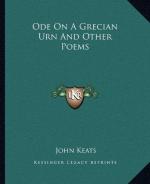|
This section contains 248 words (approx. 1 page at 400 words per page) |

|
Ode on a Grecian Urn Summary & Study Guide Description
Ode on a Grecian Urn Summary & Study Guide includes comprehensive information and analysis to help you understand the book. This study guide contains the following sections:
This detailed literature summary also contains Bibliography on Ode on a Grecian Urn by John Keats.
In "Ode on a Grecian Urn," the speaker observes a relic of ancient Greek civilization, an urn painted with two scenes from Greek life. The first scene depicts musicians and lovers in a setting of rustic beauty. The speaker attempts to identify with the characters because to him they represent the timeless perfection only art can capture. Unlike life, which in Keats's "Ode to a Nightingale" is characterized by "the weariness, the fever, and the fret" brought on by humans' awareness of their own passing, the urn's characters are frozen in time. The lovers will always love, though they will never consummate their desire. The musicians will always play beneath trees that will never lose their leaves.
The speaker admires this state of existence, but in the end it leaves his "heart high-sorrowful." This is because the urn, while beautiful and seemingly eternal, is not life. The lovers, while forever young and happy in the chase, can never engage in the act of fertility that is the basis of life, and the tunes, while beautiful in the abstract, do not play to the "sensual ear" and are in fact "of no tone." Filled with dualities-time and timelessness, silence and sound, the static and the eternal-the urn in the end is a riddle that has "teased" the speaker into believing that beauty is truth. In life, however, beauty is not necessarily truth, and the urn's message is one appropriate only in the rarefied, timeless world of art.
Read more from the Study Guide
|
This section contains 248 words (approx. 1 page at 400 words per page) |

|



